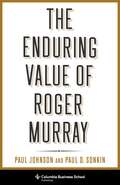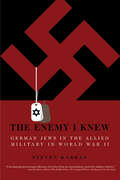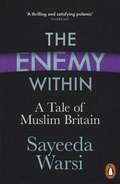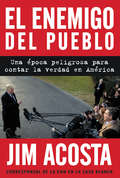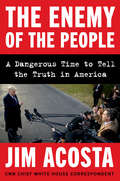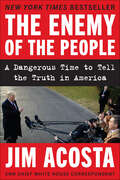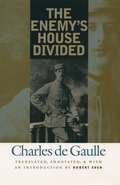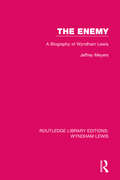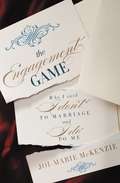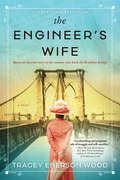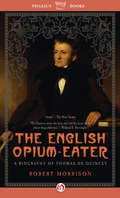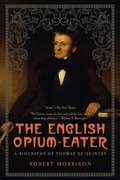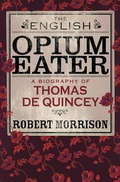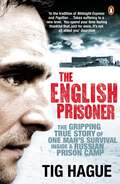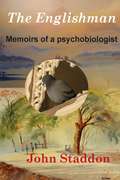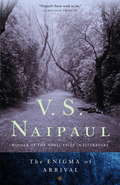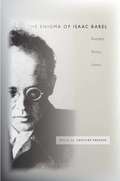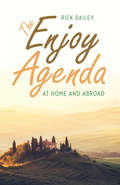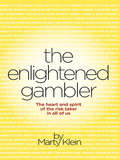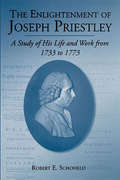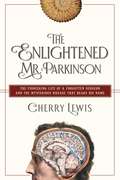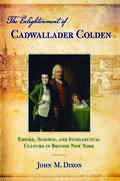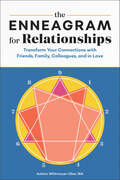- Table View
- List View
The Enduring Value of Roger Murray (Heilbrunn Center for Graham & Dodd Investing Series)
by Professor Paul Johnson Paul SonkinRoger Murray (1911–1998) was a crucial figure in the history of value investing. A financial professional, economist, adviser to members of Congress, and educator, Murray was the successor to the legendary Benjamin Graham as professor of the securities analysis course at Columbia Business School. There, he mentored generations of students, including Mario Gabelli, Charles Royce, Leon G. Cooperman, and Art Samberg.This book offers a compelling account of Murray’s multifaceted career alongside a series of remarkable lectures he gave late in his life that encapsulated his philosophy of investing. The investing professionals and educators Paul Johnson and Paul D. Sonkin chronicle Murray’s life and accomplishments, capturing his professional triumphs, theoretical insights, and lasting legacy. They highlight Murray’s educational philosophy and mentorship, including personal recollections from his students about his teaching and influence.The Enduring Value of Roger Murray features the transcripts of four lectures Murray gave in 1993, hosted by Gabelli, which became legendary in the investing community. These lectures inspired Bruce Greenwald to ask Murray to co-teach a security analysis course, leading to the resurrection of value investing education at Columbia Business School, which had waned after Murray’s retirement in 1977. Annotated by Johnson and Sonkin, these lectures are now available to a wide audience for the first time. They will be illuminating and instructive for all value investing students and practitioners today.
The Enemy I Knew: German Jews in the Allied Military in World War II
by Steven KarrasJewish refugees who fled the Nazis—then returned to fight them as Allied soldiers—share their experiences: “Heroic, poignant [and] compelling.” —The Daily NewsEven Holocaust survivor Elie Wiesel struggled with the question: Why didn’t the Jews fight back? But he finally concluded that the real question was how so many of them did. As he put it, “Tormented, beaten, starved, where did they find the strength—spiritual and physical—to resist?” In fact, over 10,000 German Jews fought in the Allied armies of World War II. This book honors those European-born combat veterans—refugees from the Nazi regime in Germany and Austria who faced their persecutors by joining the Allied forces in a fight against the country of their birth. These twenty-seven interviews take us into the unique and harrowing experiences of brave men—and one brave woman—whose service restored a sense of dignity and allowed them to rise above their former victimization. All burned with anger at the Germans who’d subjected them, often as young children, to cruelty in everyday life in their hometowns, and to ridicule in the national media. As soldiers who knew the language and psychology of the enemy better than any of their comrades, they struck back with newfound pride against the rampant injustice that had annihilated their families, destroyed their prospects, and subjected many of them to the worst forms of physical abuse, both random and terrifying. In The Enemy I Knew they tell their stories—and the world is richer for their heroic acts, and for their testimony.“It is rare to come across a book about a forgotten story from World War II, but Steve Karras has found one of the most compelling, little-known accounts from the war and he tells it brilliantly. Harrowing, breathtaking in parts, and completely absorbing.” —Andrew Carroll, New York Times–bestselling editor of War Letters“Few stories can rival the ones told in The Enemy I Knew.” —Library Journal (starred review)
The Enemy Within: A Tale of Muslim Britain
by Sayeeda Warsi'Hard headed, well informed and intellectually coherent ... it turns conventional wisdom on its head. It deserves to promote a public debate on this subject which has been needed for more than 20 years' Peter OborneBritain has often found groups within its borders whom it does not trust, whom it feels have a belief, culture, practice or agenda which runs contrary to those of the majority. From Catholics to Jews, miners to trade unionists , Marxists to liberals and even homosexuals, all have at times been viewed, described and treated as 'the enemy within'. Muslims are the latest in a long line of 'others' to be given this label. How did this state of affairs come to pass? What are the lessons and challenges for the future - and how will the tale of Muslim Britain develop? Sayeeda Warsi draws on her own unique position in British life, as the child of Pakistani immigrants, an outsider, who became an insider, the UK's first Muslim Cabinet minister, to explore questions of cultural difference, terrorism, surveillance, social justice, religious freedom, integration and the meaning of 'British values'.Uncompromising and outspoken, filled with arguments, real-life experience, necessary truths and possible ways forward for Muslims, politicians and the rest of us, this is a timely and urgent book.'This thoughtful and passionate book offers hope amid the gloom' David Anderson QC, Independent Reviewer of Terrorism Legislation'A vital book at a critical time' Helena Kennedy QC
The Enemy of the People \ El enemigo del pueblo (Spanis edition): Una época peligrosa para contar la verdad en América
by Jim AcostaDel veterano corresponsal de la Casa Blanca de la CNN, Jim Acosta, un explosivo relato de primera mano sobre los peligros que enfrenta al informar sobre la actual Casa Blanca mientras se encontraba en la primera línea de una Guerra con el presidente Trump por contar la verdad.En la campaña de Trump contra lo que él presidente llama "Noticias falsas", el corresponsal principal de la CNN en la Casa Blanca, Jim Acosta, es el enemigo público número uno. Desde el momento en que el Sr. Trump anunció su candidatura en 2015, ha atacado a los medios de comunicación y ha llamado a los periodistas "el enemigo del pueblo".Acosta presenta un examen condenatorio de la disfunción burocrática, el engaño y la amenaza sin precedentes que la retórica que dirige el señor Trump en nuestra democracia. Cuando el líder del mundo libre incita al odio y la violencia, Acosta no retrocede y exhorta a sus conciudadanos a hacer lo mismo. En el canal de televisión más odiado por el Sr. Trump, CNN, Acosta ofrece un informe nunca narrado de lo que es ser el corresponsal más odiado del presidente. Acosta se enfrenta con la Casa Blanca, incluso después de que los partidarios de Trump hayan amenazado su vida con palabras y con violencia física. Desde los nebulosos rechazos y acusaciones que pretenden desacreditar la investigación de Mueller hasta los escandalosos tuits del presidente, Jim Acosta está en el ojo de la tormenta mientras informa a millones de personas en todo el mundo. Después de pasar cientos de horas en suspenso con el personal de la Casa Blanca, Acosta pinta retratos de las personalidades de Sarah Huckabee Sanders, Stephen Miller, Steve Bannon, Sean Spicer, Hope Hicks, Jared Kushner y más. Acosta es tenaz e inflexible en su batalla pública para preservar la Primera Enmienda y lo que él llama #RealNews (#noticiasreales).
The Enemy of the People: A Dangerous Time to Tell the Truth in America
by Jim AcostaFrom CNN’s veteran Chief White House Correspondent Jim Acosta, an explosive, first-hand account of the dangers he faces reporting on the current White House while fighting on the front lines in President Trump’s war on truth. In Mr. Trump’s campaign against what he calls “Fake News,” CNN Chief White House Correspondent, Jim Acosta, is public enemy number one. <P><P>From the moment Mr. Trump announced his candidacy in 2015, he has attacked the media, calling journalists “the enemy of the people.” Acosta presents a revealing examination of bureaucratic dysfunction, deception, and the unprecedented threat the rhetoric Mr. Trump is directing has on our democracy. When the leader of the free world incites hate and violence, Acosta doesn’t back down, and he urges his fellow citizens to do the same. <P><P>At CNN, Acosta offers a never-before-reported account of what it’s like to be the President’s least favorite correspondent. Acosta goes head-to-head with the White House, even after Trump supporters have threatened his life with words as well as physical violence. From the hazy denials and accusations meant to discredit the Mueller investigation, to the president’s scurrilous tweets, Jim Acosta is in the eye of the storm while reporting live to millions of people across the world. <P><P>After spending hundreds of hours with the revolving door of White House personnel, Acosta paints portraits of the personalities of Sarah Huckabee Sanders, Stephen Miller, Steve Bannon, Sean Spicer, Hope Hicks, Jared Kushner and more. Acosta is tenacious and unyielding in his public battle to preserve the First Amendment and #RealNews. <P><b>A New York Times Bestseller</b>
The Enemy of the People: A Dangerous Time to Tell the Truth in America
by Jim AcostaA New York Times bestseller.From CNN’s veteran Chief White House Correspondent Jim Acosta, an explosive, first-hand account of the dangers he faces reporting on the current White House while fighting on the front lines in President Trump’s war on truth, featuring new material exclusive to the paperback edition. In Mr. Trump’s campaign against what he calls “Fake News,” CNN Chief White House Correspondent, Jim Acosta, is public enemy number one. From the moment Mr. Trump announced his candidacy in 2015, he has attacked the media, calling journalists “the enemy of the people.”Acosta presents a damning examination of bureaucratic dysfunction, deception, and the unprecedented threat the rhetoric Mr. Trump is directing has on our democracy. When the leader of the free world incites hate and violence, Acosta doesn’t back down, and he urges his fellow citizens to do the same.At Mr. Trump’s most hated network, CNN, Acosta offers a never-before-reported account of what it’s like to be the President’s most hated correspondent. Acosta goes head-to-head with the White House, even after Trump supporters have threatened his life with words as well as physical violence.From the hazy denials and accusations meant to discredit the Mueller investigation, to the president’s scurrilous tweets, Jim Acosta is in the eye of the storm while reporting live to millions of people across the world. After spending hundreds of hours with the revolving door of White House personnel, Acosta paints portraits of the personalities of Sarah Huckabee Sanders, Stephen Miller, Steve Bannon, Sean Spicer, Hope Hicks, Jared Kushner and more. Acosta is tenacious and unyielding in his public battle to preserve the First Amendment and #RealNews.
The Enemy's House Divided
by Charles De GaulleOriginally published in 1924 and available here in English for the first time, The Enemy's House Divided is Charles de Gaulle's analysis of the major errors that led the Germans to disaster in World War I. Based partly on observations made during his internment as a prisoner of war from 1916 to 1918, it can be seen as the foundation for everything he wrote in the 1920s and 1930s in the shadow of German resurgence and for much of what he said and did after the Nazi victory in June of 1940. To de Gaulle, the German conduct of the Great War and the debacle of 1918 was the greatest moral disaster ever to befall a modern civilized political community. He seeks to identify the internecine causes of the collapse of the German war effort in 1918 and of the subsequent dissolution of the German Empire. His diagnosis of the profound moral crisis that unfolded in Germany during World War I points forward to 1940, for de Gaulle understood the fall of France, above all, as a moral catastrophe for the French. His first book, it is also a key document of de Gaulle's "philosophy of action," introducing his statesmanship to the world with its deliberate and studied critique of the perils of Nietzsche's philosophical initiative.
The Enemy: A Biography of Wyndham Lewis (Routledge Library Editions: Wyndham Lewis #1)
by Jeffrey MeyersOriginally published in 1980 and nominated for the Duff Cooper Prize, this was the first biography of Wyndham Lewis and was based on extensive archival research and interviews. It narrates Lewis’ years at Rugby and the Slade, his bohemian life on the Continent, the creation of Vorticism and publication of Blast, and his experiences at Passchendaele, as well as his many love affairs, his bitter quarrels with Bloomsbury and the Sitwells, the suppressed books of the thirties, the evolution of his political ideas, his self-imposed exile in North America and creative resurgence during his final blindness. Jeffrey Meyers also describes Lewis’ relationships with Roy Campbell, D. H. Lawrence, Katherine Mansfield, T. E Lawrence, Hemingway, Huxley, Yeats, Auden, Spender, Orwell and McLuhan. As the self-styled Enemy emerges from the shadows, he is seen as an independent and courageous artist and one of the most controversial and stimulating figures in modern English art and literature.
The Engagement Game: Why I Said "I Don't" to Marriage and "I Do" to Me
by Joi-Marie MckenzieJoi-Marie almost has it all; a thriving career, a supportive family, great friends, and an apartment in Manhattan. What she doesn't have is a husband. Ambitious, confident, and successful, Joi-Marie believes she has it all figured out. At 28 years old, she has an enviable job as a producer, covering entertainment in New York City. Her close-knit family is loving and encouraging, and her boyfriend, Adam, is as close to perfect as you can get -- except for the fact that he won't propose. Like most women, Joi-Marie has a checklist of what the perfect life looks like. She has the career, the friends, the apartment, and the lifestyle she has always wanted. But, when the husband she wants doesn't fall into place, she decides to play the game-the engagement game-in order to get Adam to drop down on one knee. After receiving a laundry list of advice on how to secure a proposal--even researching how to cook "engagement chicken"-- Joi-Marie realizes that, in the process of trying to attain her perfect life, she has slowly become a person she doesn't recognize. With this discovery, she must make a decision: pretend to be someone she's not in order to have the life she envisioned...or have the courage to be herself and find her happily ever after in a way she never expected.
The Engineer's Wife: A Novel
by Tracey Enerson WoodTHE USA TODAY BESTSELLER!THE INTERNATIONAL BESTSELLER!She built the Brooklyn Bridge, so why don't you know her name?Emily Roebling built a monument for all time. Then she was lost in its shadow. Discover the fascinating woman who helped design and construct the Brooklyn Bridge. Perfect for book clubs and fans of Marie Benedict.Emily refuses to live conventionally—she knows who she is and what she wants, and she's determined to make change. But then her husband asks the unthinkable: give up her dreams to make his possible.Emily's fight for women's suffrage is put on hold, and her life transformed when her husband Washington Roebling, the Chief Engineer of the Brooklyn Bridge, is injured on the job. Untrained for the task, but under his guidance, she assumes his role, despite stern resistance and overwhelming obstacles. But as the project takes shape under Emily's direction, she wonders whose legacy she is building—hers, or her husband's. As the monument rises, Emily's marriage, principles, and identity threaten to collapse. When the bridge finally stands finished, will she recognize the woman who built it?Based on the true story of an American icon, The Engineer's Wife delivers an emotional portrait of a woman transformed by a project of unfathomable scale, which takes her into the bowels of the East River, suffragette riots, the halls of Manhattan's elite, and the heady, freewheeling temptations of P.T. Barnum. The biography of a husband and wife determined to build something that lasts—even at the risk of losing each other."Historical fiction at its finest."—Andrea Bobotis, author of The Last List of Miss Judith KrattOther Bestselling Historical Fiction from Sourcebooks Landmark:The Only Woman in the Room by Marie BenedictThe Mystery of Mrs. Christie by Marie BenedictThe Book Woman of Troublesome Creek by Kim Michele RichardsonSold on a Monday by Kristina McMorris
The English Opium Eater
by Robert MorrisonA masterful biography of one of England's most notorious literary figuresAuthor of the scandalous Confessions of an English Opium-Eater, Thomas De Quincey (1785-1859) has long lacked a full-fledged biography. His friendships with leading poets and men of letters in the Romantic and Victorian periods--including William Wordsworth and Samuel Taylor Coleridge--have long placed him at the center of nineteenth century literary studies. His writing was a tremendous influence on Edgar Allan Poe, Charles Dickens, and William Burroughs. De Quincey is a topical figure for other reasons, too: a self-mythologizing autobiographer whose attitudes to drug-induced creativity and addiction strike highly resonant chords for a contemporary readership. Robert Morrison's biography passionately argues for the critical importance and enduring value of this neglected icon of English literature.
The English Opium-Eater: A Biography of Thomas De Quincey
by Robert MorrisonA masterful biography of England's most notorious literary figure. Author of the scandalous Confessions of an English Opium-Eater, Thomas De Quincey (1785-1859) has long lacked a full-fledged biography. His friendships with leading poets and men of letters in the Romantic and Victorian periods-- including William Wordsworth and Samuel Taylor Coleridge--have long placed him at the center of nineteenth century literary studies. His writing was a tremendous influence on Edgar Allan Poe, Charles Dickens, and William Burroughs. De Quincey is a topical figure for other reasons, too: a self-mythologizing autobiographer whose attitudes to drug-induced creativity and addiction strike highly resonant chords for a contemporary readership. Robert Morrison's biography passionately argues for the critical importance and enduring value of this neglected icon of English literature.
The English Opium-Eater: A Biography of Thomas De Quincey
by Robert MorrisonDefinitive life of the author of CONFESSIONS OF AN ENGLISH OPIUM-EATER, journalist, political commentator and biographer.Thomas De Quincey's friendships with leading poets and men of letters in the Romantic and Victorian periods - including William Wordsworth, Samuel Taylor Coleridge and Thomas Carlyle - have long placed him at the centre of 19th-century literary studies. De Quincey also stands at the meeting point in the culture wars between Edinburgh and London; between high art and popular taste; and between the devotees of the Romantic imagination and those of hack journalism. His writing was a tremendous influence on Edgar Allan Poe, Charles Dickens, William Burroughs and Peter Ackroyd.De Quincey is a fascinating (and topical) figure for other reasons too: a self-mythologizing autobiographer whose attitudes to drug-induced creativity and addiction strike highly resonant chords for a contemporary readership. Robert Morrison's biography passionately argues for the critical importance and enduring value of this neglected essayist, critic and biographer.
The English Opium-Eater: A Biography of Thomas De Quincey
by Robert MorrisonDefinitive life of the author of CONFESSIONS OF AN ENGLISH OPIUM-EATER, journalist, political commentator and biographer.Thomas De Quincey's friendships with leading poets and men of letters in the Romantic and Victorian periods - including William Wordsworth, Samuel Taylor Coleridge and Thomas Carlyle - have long placed him at the centre of 19th-century literary studies. De Quincey also stands at the meeting point in the culture wars between Edinburgh and London; between high art and popular taste; and between the devotees of the Romantic imagination and those of hack journalism. His writing was a tremendous influence on Edgar Allan Poe, Charles Dickens, William Burroughs and Peter Ackroyd.De Quincey is a fascinating (and topical) figure for other reasons too: a self-mythologizing autobiographer whose attitudes to drug-induced creativity and addiction strike highly resonant chords for a contemporary readership. Robert Morrison's biography passionately argues for the critical importance and enduring value of this neglected essayist, critic and biographer.
The English Prisoner: The Gripping True Story Of One Man's Survival Inside A Russian Prison Camp
by Tig HagueIn July 2003 young Englishman Tig Hague was on a routine business trip to Moscow when he was arrested at the airport. Within hours he was accused of a major crime. Next, he was tried and transported hundreds of miles to the remote, forsaken wastes of Mordovia.And prison camp Zone 22.Sentenced to spend the next four years there, every day was a struggle against disease, freezing temperatures, malnutrition, the unpredictable, sometimes terrifying behaviour of the camp guards and his fellow prisoners.But, most of all, it was a fight to ensure his own psychological survival.Only the thought of his girlfriend Lucy, fighting Russia's corrupt and labyrinthine legal system, kept Tig sane - and gave him a reason to see each day to its end.The English Prisoner is an extraordinary story of endurance, as one man - plucked from his normal, everyday life - is forced to reach deep inside himself to survive life in one of the bleakest outposts in the world: Russia's vast and unforgiving 'forgotten zone'.
The Englishman: Memoirs of a Psychobiologist
by John Staddon"Although I have been basically an academic for most of my life, the way I got there has taken some surprising turns. The first four chapters of this memoir describe what I can remember and discover about my early life: an unsuspected ancestry, fun in WW2 London, comical schooldays, and a spell in colonial Africa interrupting a wobbly college career at the end of which I left England for America. In the US I followed again a slightly erratic graduate-school trajectory that ended up in a Harvard basement."This is not just a witty transatlantic autobiography from a talented English working-class kid who made his name in the USA but also a learned and entertaining romp through the subject he has made his own. Growing up in a modest odd family out in wartime England, and with a natural resistance to regimentation, John Staddon was the precocious self-driven polymath who first studied chemical engineering but switched to psychology because there were only four or five classes a week. By way of his wide-ranging interests in biology, artificial intelligence, economics, philosophy and behavioural neuroscience, John Staddon introduces his important work on how animals learn. He discusses the still relatively new and exciting field of behavioural psychobiology, explains theoretical research on choice and interval timing and debates so-called superstition in the learned behaviour of pigeons, rats, fish - and people. Here is a most entertaining life story interwoven with expansive thoughts across the marvellously wide spectrum of behavioural psychology.
The Enigma of Arrival (Vintage International)
by V. S. NaipaulThe Nobel Prize-winning author distills his wide experience of countries and peoples into a moving account of the rites of passage endured by all people and all communities undergoing change or decay. • "Naipaul's finest work." —Chicago Tribune"A subtly incisive self-reckoning." —The Washington Post Book WorldThe story of a writer&’s singular journey – from one place to another, and from one state of mind to another. At the midpoint of the century, the narrator leaves the British colony of Trinidad and comes to the ancient countryside of England. And from within the story of this journey – of departure and arrival, alienation and familiarity, home and homelessness – the writer reveals how, cut off from his &“first&” life in Trinidad, he enters a &“second childhood of seeing and learning.&”Clearly autobiographical, yet woven through with remarkable invention, The Enigma of Arrival is as rich and complex as any novel we have had from this exceptional writer."The conclusion is both heart-breaking and bracing: the only antidote to destruction—of dreams, of reality—is remembering. As eloquently as anyone now writing, Naipaul remembers." —Time"Far and away the most curious novel I've read in a long time, and maybe the most hypnotic book I've ever read." —St. Petersburg Times
The Enigma of Isaac Babel
by Gregory FreidinFreidin (Slavic languages and literature, Stanford U. ) presents 12 papers exploring the life and work of Soviet writer Isaac Babel (1894-1940), who produced a number of short stories, two plays, and various newspaper articles before he became a victim of the Stalinist purges. The papers reconstruct his biography; place his writings in the context of the turbulent political, cultural, and social circumstances of the first decades following the Russian Revolution; and conduct analyses of more specifically literary issues, such as Babel's debt to Flaubert and his use of linguistic elements of Russian, Yiddish, and Hebrew in his works. Annotation c2010 Book News, Inc. , Portland, OR (booknews. com)
The Enigma of Max Gluckman: The Ethnographic Life of a "Luckyman" in Africa (Critical Studies in the History of Anthropology)
by Robert J. GordonThe Enigma of Max Gluckman examines one of the most influential British anthropologists of the twentieth century. South African–born Max Gluckman was the founder of what became known as the Manchester School of social anthropology, a key figure in the anthropology of anticolonialism and conflict theory in southern Africa, and one of the most prolific structuralist and Marxist anthropologists of his generation. From his position at Oxford University as graduate student and lecturer to his career at Manchester, Gluckman was known to be generous and engaged with his closest colleagues but brutish and hostile in his denunciations of their work if it did not contribute to the social justice and activist vision he held for the discipline. Conventional histories of anthropology have treated Gluckman as an outlier from mainstream British social anthropology based on his career at the University of Manchester and his gruff manner. He was certainly not the colonial gentleman typical of his British colleagues in the field. Gluckman was deeply engaged with field research in southern Africa on the Zulus, in Barotseland with the Lozi, and also in connection with his directorship of the Rhodes-Livingstone Institute from 1941 to 1947, which obscured his growing critique of anthropology’s methods and ties to Western colonialism and racial oppression in the subcontinent. Robert J. Gordon’s biography skillfully reexamines the colorful life of Max Gluckman and restores his career in the British anthropological tradition.
The Enjoy Agenda: At Home and Abroad
by Rick BaileyPart memoir, part travelogue, The Enjoy Agenda takes readers from Rick Bailey’s one-stoplight town in Michigan farm country to Stratford, England, to the French Concession in Shanghai, the Adriatic coast of Italy, and to a small village in the Republic of San Marino. With his self-deprecating style, Bailey recalls the traumas of picture day in elementary school and lugging a guitar to the Cotswalds and back. He reflects on food safety in China, relives a dental emergency in Venice, and embarks on a quest for il formaggio del perdono (the cheese of forgiveness) in the hills above the Adriatic. Bailey, whose voice is a combination of Dave Barry and Rick Steves with just a soupçon of Montaigne, writes with humor and wit about how these experiences reflect the issues and conflicts of contemporary American life: environmental change, life in digital times, and the vicissitudes of arriving at ripe old age. Throughout The Enjoy Agenda Bailey asks, “Where am I and how did I get here?” a question less about geography than the difficulties and gifts of becoming a husband and ultimately a partner changed and improved by a very smart woman and challenged and delighted by a gradual but seismic culture shift.
The Enlightened Gambler
by Marty KleinSo, you like gambling and you want to play? Well, if you want to play, you may have to pay! If you don't watch it you can get tossed around like a tumbleweed on a windy day. You might have to either lose your stubborn defiance or your shirt. So... which one you gonna choose? The Enlightened Gambler guides the reader through the author's world of gambling, seduced by the never ending excitement in the "land of uncertainty". . The book encourages readers to step past the superficial and take a more conscious view of the motivating drive in all of us to take risks. In a lighthearted, sometimes laugh-out-loud, self deprecating style, the author playfully and willingly exposes his own vulnerability to the seductive lure of gambling, but then points out ways to encourage winning attitudes, which he has developed over the years, while defusing old, toxic, loser mentality.
The Enlightened Joseph Priestley: A Study of His Life and Work from 1733 to 1773
by Robert SchofieldJoseph Priestley (1733–1804) is one of the major figures of the English Enlightenment. A contemporary and friend of Benjamin Franklin and Thomas Jefferson, he exceeded even these polymaths in the breadth of his curiosity and learning. Yet no one has attempted an all-inclusive biography of Priestley, probably because he was simply too many persons for anyone easily to comprehend in a single study. Robert Schofield has devoted a lifetime of scholarship to this task. The result is a magisterial book, covering the life and works of Priestley during the critical first forty years of his life. <P><P>Although Priestley is best known as a chemist, this book is considerably more than a study in the history of science. As any good biographer must, Schofield has thoroughly studied the many activities in which Priestley was engaged. Among them are theology, electricity, chemistry, politics, English grammar, rhetoric, and educational philosophy. Schofield situates Priestley, the provincial dissenter, within the social, political, and intellectual contexts of his day and examines all the works Priestley wrote and published during this period. <P><P>Schofield singles out the first forty years of Priestley's life because these were the years of preparation and trial during which Priestley qualified for the achievements that were to make him famous. The discovery of oxygen, the defenses of Unitarianism, and the political liberalism that characterize the mature Priestley—all are foreshadowed in the young Priestley. A brief epilogue looks ahead to the next thirty years when Priestley was forced out of England and settled in Pennsylvania, the subject of Schofield's next book. But this volume stands alone as the definitive study of the making of Joseph Priestley.
The Enlightened Mr. Parkinson: The Pioneering Life Of A Forgotten Surgeon
by Cherry LewisA colorful and absorbing portrait of James Parkinson and the turbulent, intellectually vibrant world of Georgian London. Parkinson’s disease is one of the most common forms of dementia, with 60,000 new cases each year in the United States alone, yet few know anything about the man the disease is named after. In 1817—two hundred years years ago—James Parkinson (1755–1824) defined this mysterious ailment so precisely that we still diagnose Parkinson's Disease today by recognizing the symptoms he identified. The story of this remarkable man’s contributions to the Age of the Enlightenment is told through his three seemingly disparate passions: medicine, politics and fossils. As a political radical, Parkinson was interrogated over a plot to kill King George III and was in danger of exile. But simultaneously, he was helping Edward Jenner set up smallpox vaccination stations across London and writing the first scientific study of fossils in English, jump-starting a national craze. He is one of the intellectual pioneers of "the age of wonder," forgotten to history, but Cherry Lewis restores this amazing man to his rightful place in history with her evocative portrait of the man and his era.
The Enlightenment of Cadwallader Colden: Empire, Science, and Intellectual Culture in British New York
by John M. DixonWas there a conservative Enlightenment? Could a self-proclaimed man of learning and progressive science also have been an agent of monarchy and reaction? Cadwallader Colden (1688-1776), an educated Scottish emigrant and powerful colonial politician, was at the forefront of American intellectual culture in the mid-eighteenth century. While living in rural New York, he recruited family, friends, servants, and slaves into multiple scientific ventures and built a transatlantic network of contacts and correspondents that included Benjamin Franklin and Carl Linnaeus. Over several decades, Colden pioneered colonial botany, produced new theories of animal and human physiology, authored an influential history of the Iroquois, and developed bold new principles of physics and an engaging explanation of the cause of gravity. The Enlightenment of Cadwallader Colden traces the life and ideas of this fascinating and controversial "gentleman-scholar." John M. Dixon's lively and accessible account explores the overlapping ideological, social, and political worlds of this earliest of New York intellectuals. Colden and other learned colonials used intellectual practices to assert their gentility and establish their social and political superiority, but their elitist claims to cultural authority remained flimsy and open to widespread local derision. Although Colden, who governed New York as an unpopular Crown loyalist during the imperial crises of the 1760s and 1770s, was brutally lampooned by the New York press, his scientific work, which was published in Europe, raised the international profile of American intellectualism.
The Enneagram for Relationships: Transform Your Connections with Friends, Family, Colleagues, and in Love
by Ashton Whitmoyer-OberCultivate deeper relationships—a guide to the power of the Enneagram.We all relate to the people around us in different ways and understanding those differences is the key to maintaining healthy relationships. The Enneagram for Relationships takes the straightforward wisdom of the Enneagram and helps you understand it so that you can improve the quality of your human connections.Breaking people down into nine distinct types, the Enneagram is more than a personality test—it is a tool for understanding who you are and, more importantly, why you are who you are. Diving deep into each of the types, this easy-to-understand book provides complete breakdowns of what each one brings to various relationships, how they interact with other people, and what they can do to form healthy and fulfilling partnerships.The Enneagram for Relationships includes:Learn about your type—From the Reformer (Type 1) to the Peacemaker (Type 9), get a detailed explanation of each personality, what they are like, and how they function within relationships.From personal to professional—Go beyond romance as you learn how you can use the Enneagram to improve friendships, familial bonds, and work partnerships.Be your best self—Discover plenty of practical advice for addressing your own faults and foibles and living up to your potential—even as you learn how to navigate the other personality types at home and in the wild.You can get along better with other people—let the Enneagram show you how.
